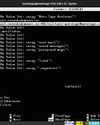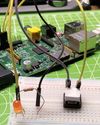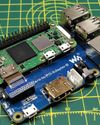Set up Sense HAT inputs in Scratch 3
Linux Format
|September 2021
Les Pounder shows how to obtain data and control sprites using the Sense HAT add-on board with Scratch 3.

YOU NEED
- Raspberry Pi 3B+ or better
- Sense HAT
- Latest Raspbian release
- Code: https:// github.com/ lesp/ LXF280Sense-Bats/ archive/ refs/heads/ main.zip
This month we’ll use the scientific powerhouse Sense HAT board with Scratch 3 to create four quick projects to demonstrate the power of Scratch 3 and the Sense HAT.
The Sense HAT is a remarkable board. Released in 2015, it works with Python, Node-RED and for this tutorial it works with Scratch 3 thanks to a special palette of blocks that enable anyone to use the sensors, display and joystick with very little coding knowledge.
With the power off, connect the Sense HAT to all 40 pins of the GPIO, ensuring that the board fits neatly over the Pi. Use the brass standoff, provided with the Sense HAT to fix the board firmly in place. Connect your peripherals and then power up the Raspberry Pi to the desktop.
Scratch 3 should come pre-installed on your Raspberry Pi OS image, but just in case it’s missing it can be installed from the main menu, under Preferences>Recommended Software. Scratch 3 is found in the Programming category: place a tick in the box and click Apply to install. Once installed, Scratch 3 can be found in the main menu under Programming.
Open Scratch 3 (on first start Scratch may take a little while to open). We’re going to assume that you have an understanding of how to code with Scratch, but if not we covered the basics in previous issues. Before we write any new code we need to click the blue folder icon in the bottom left of the screen to load the Extensions menu. From there select Raspberry Pi Sense HAT and a palette of new blocks are added to our code.
Project 1: Spin me right round
このストーリーは、Linux Format の September 2021 版からのものです。
Magzter GOLD を購読すると、厳選された何千ものプレミアム記事や、10,000 以上の雑誌や新聞にアクセスできます。
すでに購読者ですか? サインイン
Linux Format からのその他のストーリー

Linux Format
Create your first WebSocket service
Mihalis Tsoukalos explains how to use the Go programming language to work with the WebSocket protocol.
9 mins
April 2023

Linux Format
Fantastic Mr Firefox
Nick Peers takes a trip down memory lane to reveal the story behind the rise - and slight fall - of Mozilla's popular web browser.
9 mins
April 2023

Linux Format
Set up your terminal and email like it's 1983
Jump in the hot terminal time machine with Mats Tage Axelsson who emails from the command line using the latest technology.
8 mins
April 2023

Linux Format
Universal layer text effects with GIMP
Posters use them, films and presentations are hard to imagine without them: text effects. Attract attention with Karsten Günther and GIMP.
8 mins
April 2023

Linux Format
Jump to a federated social network
Nick Peers reveals how you can get up and running with this free, decentralised and non-profit alternative to Twitter.
9 mins
April 2023

Linux Format
Free our SOFTWARE!
Taking anything for granted is dangerous, so Jonni Bidwell and Mike Saunders revisit how the free software movement got started to help free us from proprietary tyranny!
4 mins
April 2023

Linux Format
Master RPI.GPIO
Les Pounder goes back to the early days of the Raspberry Pi - and his career with this classic library! -
5 mins
April 2023

Linux Format
Waveshare Zero to Pi3
Transform your Pi Zero into a Pi 3, they promised Les Pounder, but it's more like adding on go-faster stripes.
2 mins
April 2023

Linux Format
The Best OPEN SOURCE Software Ever!
In an attempt to trigger controversy, Michael Reed and Neil Mohr unequivocally state these are the greatest free software apps ever. Probably. We’re just trying to be helpful.
19 mins
April 2023

Linux Format
Linux-Mandrake 7
Simplicity and a wide range of applications make this a great distribution for all Linux users.
2 mins
April 2023
Translate
Change font size

